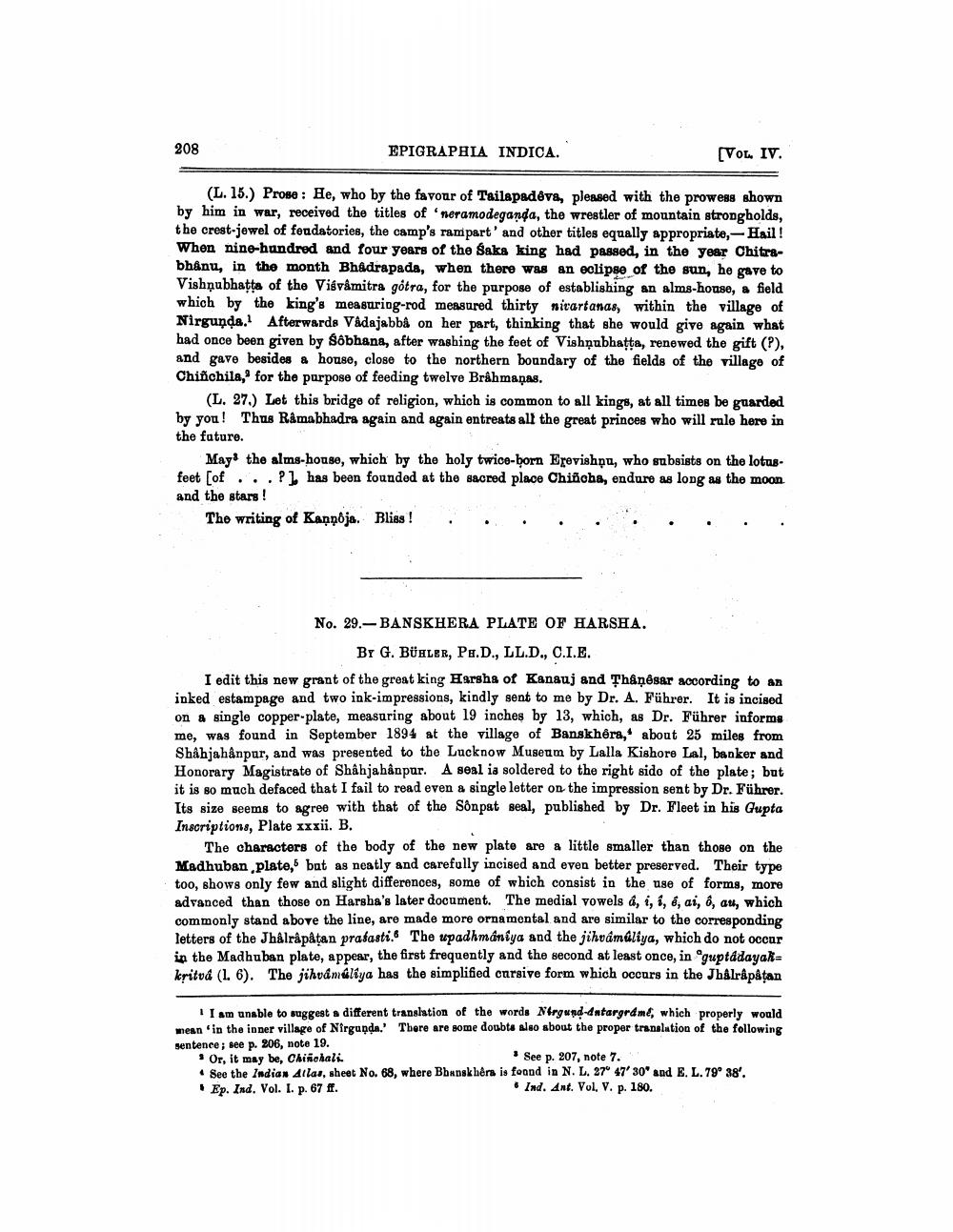________________
208
EPIGRAPHIA INDICA.
[Vol. IV.
(L. 15.) Prose: He, who by the favour of Tailapadova, pleased with the prowegs shown by him in war, received the titles of 'neramodeganda, the wrestler of mountain strongholds, the crest-jewel of feudatories, the camp's rampart' and other titles equally appropriate,- Hail! When nine-hundred and four years of the Saks king had passed, in the year Chitrabhånu, in the month Bhadrapada, when there was an eclipse of the sun, he gave to Vishņubhatta of the Vigvamitra götra, for the purpose of establishing an alms-house, a field which by the king's measuring-rod measured thirty mirartanas, within the village of Nirgunda. Afterwards Vadajabbê on her part, thinking that she would give again what had once been given by Sôbhana, after washing the feet of Vishnubhatta, renewed the gift (?), and gave besides a house, close to the northern boundary of the fields of the village of Chiñchila," for the purpose of feeding twelve Brahmaņas.
(L. 27.) Let this bridge of religion, which is common to all kings, at all times be guarded by you! Thus Råmabhadra again and again entreats all the great princes who will rule here in the fature.
May the alms-house, which by the holy twice-born Erevishnu, who subsists on the lotusfeet [of...?has been founded at the sacred place Chincha, endure as long as the moon and the stars!
The writing of Kanņoja. Bliss !
No. 29.- BANSKHERA PLATE OF HARSHA.
BY G. BÜHLER, PA.D., LL.D., C.I.E. I edit this new grant of the great king Harshs of Kansuj and Than@sar according to an inked estampage and two ink-impressions, kindly sent to me by Dr. A. Führer. It is incised on a single copper-plate, measuring about 19 inches by 13, which, as Dr. Führer informs me, was found in September 1894 at the village of Banskhera, about 25 miles from Shahjahanpur, and was presented to the Lucknow Museum by Lalla Kishore Lal, banker and Honorary Magistrate of Shahjahanpur. A seal ia soldered to the right sido of the plate; but it is so much defaced that I fail to read even a single letter on the impression sent by Dr. Führer. Its size seems to agree with that of the Sônpat seal, published by Dr. Fleet in his Gupta Inscriptions, Plate xxxii. B.
The characters of the body of the new plate are a little smaller than those on the Madhuban ,plate, bat as neatly and carefully incised and even better preserved. Their type too, shows only few and slight differences, some of which consist in the use of forms, more advanced than those on Harsha's later document. The medial vowels a, i, i, o, ai, 6, au, which commonly stand above the line, are made more ornamental and are similar to the corresponding letters of the Jhâlrâpåtan prafasti. The upadhmániya and the jihvamdliya, which do not occur in the Madhuban plate, appear, the first frequently and the second at least once, in oguptadayal - kritvå (1. 6). The jihvandliya has the simplified carsive form which occurs in the Jhalrapatan
II am unable to suggest a different translation of the words Nirgund-datargrame, which properly would wean in the inner village of Nirgunda. There are some doubts also about the proper translation of the following sentence; see p. 206, note 19. • Or, it may be, Chitchali.
See p. 207, note 7. • See the Indian Allas, sheet No. 68, where Bhanskhêrs is food in N. L. 37° 47' 30' and E. L. 79° 38'. Ep. Ind. Vol. I. p. 67 ff.
. Ind. Ant. Vol. V. p. 180.




